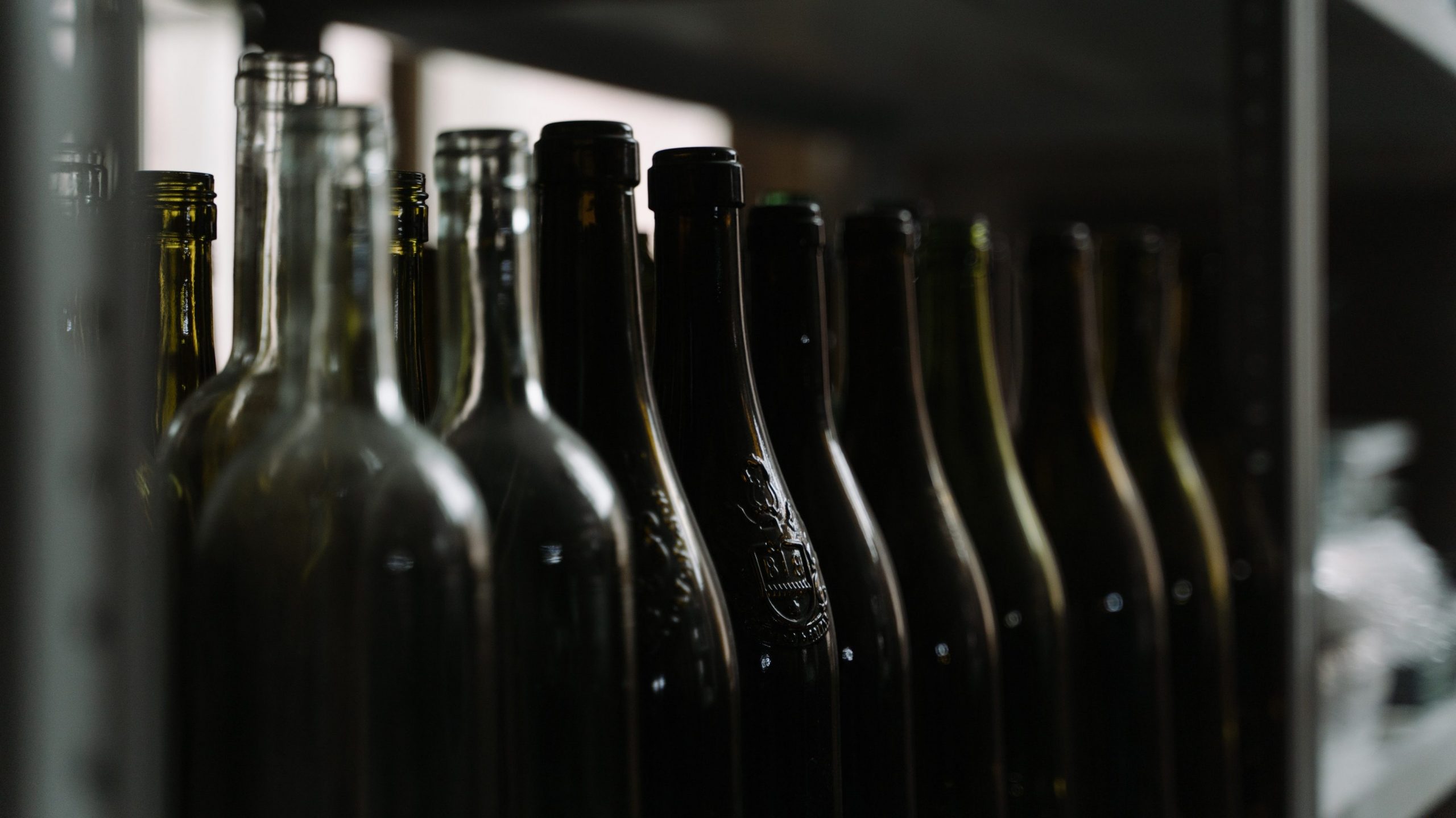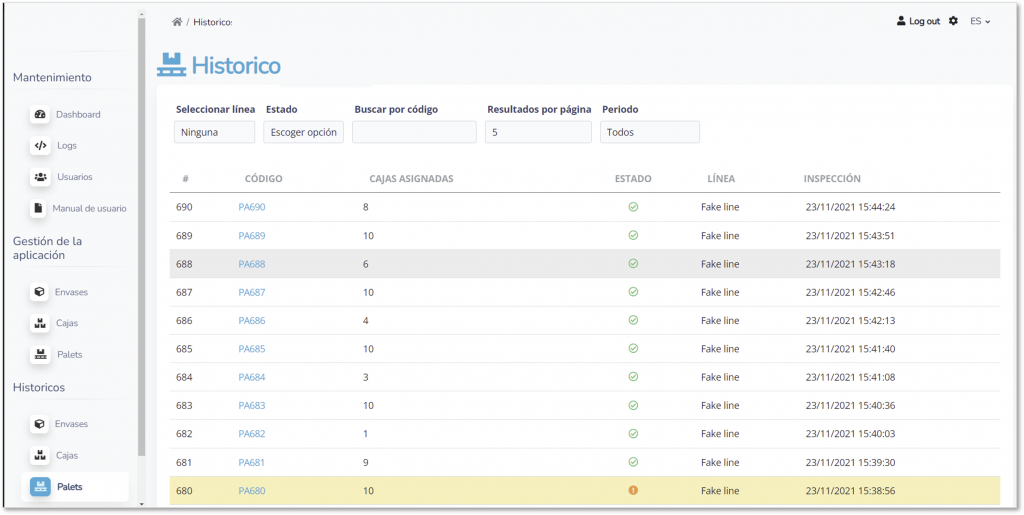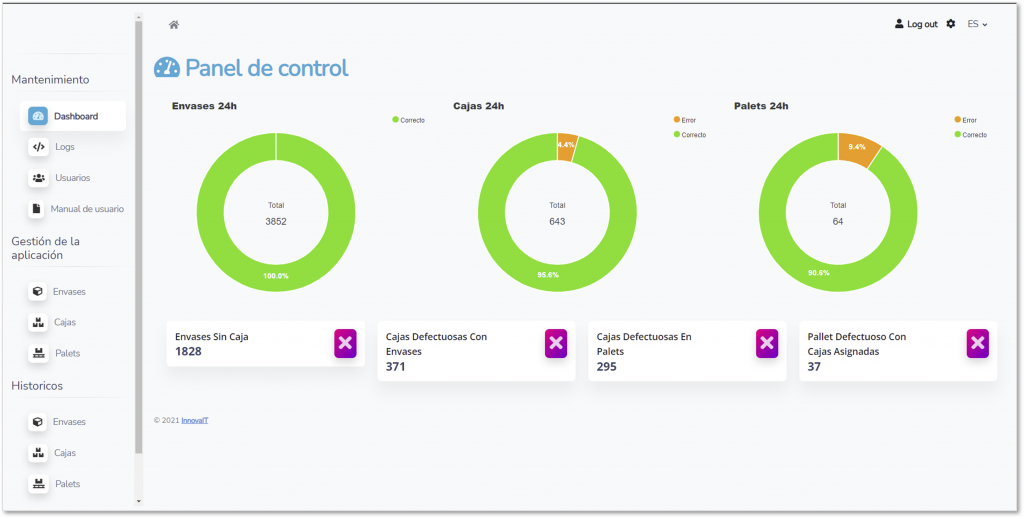This traceability solution for quality control system was developed in a company specialising in the design, manufacture and installation of machine vision inspection systems, orientators and reject systems for all types of packaging for quality control in production lines. Its implementation became necessary because the company had to respond to the growing demand for a traceability solution for customers.

Existing challenges
Due to the growing demand for a traceability solution for the customers it served, the company had several needs:
- Expand its offer with solutions (such as Industry 4.0) for the new needs of present and future customers.
- Achieve/Continue international expansion and consolidate leadership in the domestic market.
- Increase current business lines.
- Obtain new indicators for the final customer that will help them to make decisions.
- Obtain new general indicators that will allow the company to make a qualitative analysis of the services it offers; and thus distinguish what will differentiate it from the competition.
- Design a disruptive solution with a high impact on added value that improves the service being provided to customers.
Solution that was proposed
To provide a solution to all those needs through the implementation of a production traceability system in the machines manufactured by the company; in the inspection and identification of the containers, the packaging of several containers in a box (boxing) and the palletisation of the same on pallets for distribution.
The solutions to implement would be within the scope of automation and IoT with respect to the traceability solution; and to leave the platform with data connectivity from possible customer ERP’s and parameterisation, and big data with respect to the analysis and implementation of Dashboards and reports.
Planning
Implementation was forecast for the period: last quarter of 2020 and first half of 2021.
Service objectives (qualitative and quantitative)
- Implement a technological traceability solution that would allow the company to have a solution that can be integrated into all the machines that the client requires a traceability solution.
- Allow connectivity with the existing control software and with the various systems that their clients may have (ERP’s, CMMS’s, MES, GIS…).
- Development of a modular solution, to allow different configurations depending on the services required by the end customer.
- To grow in functionalities according to market demand.
- To have an open source programme, in order to allow other developers to make modifications to the application if the company so decides.
Outreach and results achieved
The implementation of a production traceability system was carried out (on a prototype of the company’s machine) in the inspection and identification of the containers, the packing of several containers in a box (boxing) and the palletisation of the same on pallets for distribution. The following were the phases of the project:
1- Definition of requirements:
Joint work sessions were held to specify the detailed functional requirements, the interfaces with the company’s system, the details of the information to be processed, the structure of the DB and the data exploitation screens.
2- System architecture:
The company’s system has a centralised server that manages the activity of the different machine vision systems. The platform was installed on a dedicated server, comparable in terms of performance to the company’s system. A communications interface has been established between the two systems based on SQL protocol so that the company’s system communicates with the platform the bottle, case and pallet records.
3- DB structure and history logging:
Definition of the DB structure and sizing according to the frequency and volume of historical data (clusters, dedicated servers…), as well as the period to store these historical data.
4- Development of the Front-End of the application:
Platform, based on a web environment, allows access to the configuration of crates and bottles to modify the components (defective, broken, …). Modifications are properly recorded to maintain the traceability of the system. The application allows the label of the modified item to be reprinted by means of an interface with the printing module of the company’s system, to which the required information is attached.
5- Dashboards and reports:
The dashboard displays the codes of the last bottles; the codes and composition of the last crates; and the code and composition of the last pallets. The reports allow you to select a time frame and/or a range of codes and a report will be generated with the cases or pallets with the details of their composition.



6- Installation, testing and deployment:
Installation and parameterisation of the platform, configuration of the interfaces with the company, deployment of the solution and installation validation tests.
Results
After the various stress tests, the application is validated according to the functionalities specified by the company. And the following improvements in the field of Industry 4.0 are achieved:
- Integration in all the machines that the customer requires a traceability solution, making it possible to offer a broader and improved solution. This will provide a disruptive solution with a high impact on the added value of the company, which will allow growth and improvement in services and in different lines of business; allowing the consolidation and loyalty of existing customers and opening up the possibility of working with new customers.
- Connectivity with the company’s existing control software and with the different systems that its clients may have (ERP’s, CMMS’s, MES, GIS…).
- A solution developed in a modular way, to allow configurations depending on the services required by the end customer.
- To grow in functionalities according to market demand.
- Solution programmed in open source, allowing other developers to make modifications to the application if the company so decides.
Did you like this article?
Receive new articles about technology and industry trends, and Industry 4.0 in your email weekly.
Subscribe to our newsletter
If you would like more information or have questions or ideas you would like to share with Innova IT: send us a message to comercial@innovait.cat or fill in the form below and we will get back to you as soon as possible.
For something more specific and concrete, make an appointment to visit us at our office.

